Eco-Friendly Optimum Structural Concrete Mix Design
Abstract
:1. Introduction
2. Experimental Program
2.1. Concrete Mix Components
2.2. Concrete Mix Design
2.3. Conducted Experiments
- Slump test according to ASTM C143 [33];
- Compressive strength at 7, 28, and 90 days according to ASTM C39 [34];
- Splitting tensile strength at 28 days according to ASTM C496 [37];
3. Results
3.1. Slump Test Results
3.2. Compressive Strength Results
3.3. Modulus of Elasticity
3.4. Splitting Tensile Strength
- A total of 5% WA for cement and 20% WA for sand with an increase of 6.6%;
- A total of 15% WA for cement and 75% RC for gravel with an increase of 6.6%;
- A total of 20% WA for cement and 100% RC for gravel with an increase of 7.9%;
- A total of 2% CR for cement and 50% RC for gravel with an increase of 2.4%
4. Eco-Friendly Mixes
5. Conclusions
- Slump
- ○
- An increase in the percentages of the RC replacement of gravel resulted in an increase in slump due to the irregularity of the RC shape.
- ○
- An increase in the percentages of the CG replacement of gravel resulted in an increase in slump as a result of a smooth surface and the angular shape of glass waste.
- ○
- An increase in the percentages of the WA replacement of cement resulted in a decrease in slump due to the additional absorption of WA, resulting in a decrease in the water–cement ratio.
- ○
- An increase in the percentages of the CR replacement of sand resulted in an increase in slump after an initial decrease at the lower replacement percentages due to the smooth surface of the CR.
- ○
- An increase in the percentages of the WA replacement of sand resulted in an increase in slump after an initial decrease at the lower replacement percentages due to the increase in the material that could be classified as binder.
- ○
- An increase in the percentages of the FCG replacement of sand resulted in an increase in slump due to the minute size of material allowing it to fill voids.
- ○
- For two-waste-materials replacement percentages, the slump was equal or exceeded the reference mix except for the cases where one of the waste materials was WA replacing sand, which resulted in lower slump values, as indicated previously for only WA replacement.
- ○
- For three-waste-materials replacement percentages, the slump was equal or exceeded the reference mix for the combinations, as the different materials were able to compensate for each other’s deficiencies.
- Compressive Strength
- ○
- For individual waste materials replacement: The seven-day tests for 20% WA replacing sand results achieved the maximum value but still less than the reference mix, with the 28-day results being almost identical to the reference mix. As for the 90-day results, the 15% and 20% WA replacing sand resulted in almost identical values as the reference mix. In addition, a great improvement in values for 5% CG for gravel and 100% RC for gravel were obtained. Both WA and CG had binder effects and RC added a residue of cement to the mixes.
- ○
- For two-waste-materials replacement: The test results at 90 days for 10%, 15%, and 20% WA replacing sand combined with 50%, 75%, and 100% RC replacing gravel reached greater values than those of the reference mix, whereas 5% WA for cement in combination with 25% WA for sand resulted in almost identical values as the reference mix at 90 days.
- ○
- For three-waste-materials replacement: The best test results were at 90 days for a combined mix of 2% WA replacing sand, 2% CR replacing sand, and 5% CG replacing gravel, which reached a value of almost 95% of the reference mix.
- Splitting Tensile Strength
- ○
- For individual waste materials replacement: The test results for 15% and 20% WA replacing sand achieved greater values than the reference mix, whereas the test results for 100% RC replacing gravel were almost identical to those of the reference mix.
- ○
- For two-waste-materials replacement: The test results for the combination of 5% WA replacing cement plus 25% WA replacing sand, 15% WA replacing sand plus 75% RC replacing gravel, 20% WA replacing sand plus 100% RC replacing gravel, and 2% CR replacing sand plus 50% RC replacing gravel reached greater values than the results of the reference mix.
- ○
- For three-waste-materials replacement: The only test results that were greater than those of the reference mix were realized from a combined mix of 2% WA replacing sand, 2% CR replacing sand, and 5% CG replacing gravel.
Author Contributions
Funding
Institutional Review Board Statement
Informed Consent Statement
Data Availability Statement
Acknowledgments
Conflicts of Interest
References
- UNECE. Air Pollution. Available online: https://unece.org/air-pollution-and-health (accessed on 24 February 2022).
- Lehne, J.; Preston, F. Making Concrete Change: Innovation in Low-Carbon Cement and Concrete. 2018. Available online: https://www.chathamhouse.org/2018/06/making-concrete-change-innovation-low-carbon-cement-and-concrete (accessed on 24 February 2022).
- Greenspec. Environmental Impacts of Concrete. Available online: https://www.greenspec.co.uk/building-design/environmental-impacts-of-concrete/ (accessed on 24 February 2022).
- Meyer, C. Concrete Materials and Sustainable Development in the United States. Struct. Eng. Int. 2004, 14, 203–207. [Google Scholar] [CrossRef]
- Sonibare, O.O.; Adeniran, J.A.; Bello, I.S. Landfill air and odor emissions from an integrated waste management facility. J. Environ. Health Sci. Eng. 2019, 17, 13–28. [Google Scholar] [CrossRef] [PubMed]
- WHO. Air Pollution. 2016. Available online: https://www.who.int/health-topics/air-pollution#tab=tab_2 (accessed on 24 February 2022).
- IPEC. Waste Tires Treatment Technologies. Available online: https://tdplant.com/news/waste-tires-conversion-technologies (accessed on 24 February 2022).
- Issa, C.A.; Salem, G. Utilization of recycled crumb rubber as fine aggregates in concrete mix design. Constr. Build. Mater. 2013, 42, 48–52. [Google Scholar] [CrossRef]
- Eldin, N.N.; Senouci, A.B. Rubber-tire particles as concrete aggregate. J. Mater. Civ. Eng. 1993, 5, 478–496. [Google Scholar] [CrossRef]
- Bušić, R.; Miličević, I.; Kalman Šipoš, T.; Jeleč, K. Recycled Rubber as an Aggregate Replacement in Self-Compacting Concrete. Materials 2018, 11, 1729. [Google Scholar] [CrossRef] [Green Version]
- Tripathi, A.; Baniya, M. Use of Recycled Tires as Partial replacement of Coarse Aggregate in the Production of Concrete. Int. J. Civ. Eng. 2017, 4. [Google Scholar]
- Gerges, N.N.; Issa, C.A.; Fawaz, S. Rubber Concrete: Mechanical and Dynamical Properties. J. Case Stud. Constr. Mater. 2018, 9, 13. [Google Scholar] [CrossRef]
- Huang, W.; Huang, X.; Xing, O.; Zhou, Z. Strength reduction factor of crumb rubber as fine aggregate replacement in concrete. J. Build. Eng. 2020, 32, 6. [Google Scholar] [CrossRef]
- Wang, J.; Du, B. Experimental studies of thermal and acoustic properties of recycled aggregate crumb rubber concrete. J. Build. Eng. 2020, 32, 7. [Google Scholar] [CrossRef]
- Amiri, M.; Hatami, F.; Golafshani, E.M. Evaluating the synergic effect of waste rubber powder and recycled concrete aggregate on mechanical properties and durability of concrete. J. Case Stud. Constr. Mater. 2021, 15, 8. [Google Scholar] [CrossRef]
- Environmental Protection Agency (EPA). Glass: Material-Specific Data. 2018. Available online: https://www.epa.gov/facts-and-figures-about-materials-waste-and-recycling/glass-material-specific-data (accessed on 24 February 2022).
- Gerges, N.N.; Issa, C.A.; Fawaz, S.A.; Jabbour, J.; Jreige, J.; Yacoub, A. Recycled Glass Concrete: Coarse and Fine Aggregates. Eur. J. Eng. Res. Sci. 2018, 3, 1–9. [Google Scholar] [CrossRef] [Green Version]
- Khan, M.N.N.; Saha, A.K.; Sarker, P.K. Reuse of waste glass as a supplementary binder and aggregate for sustainable cement-based construction materials: A review. J. Build. Eng. 2020, 28, 19. [Google Scholar] [CrossRef]
- Guo, P.; Meng, W.; Nassif, H.; Gou, H.; Bao, Y. New perspectives on recycling waste glass in manufacturing concrete for sustainable civil infrastructure. Constr. Build. Mater. 2020, 257, 15. [Google Scholar] [CrossRef]
- Abdelli, H.E.; Mokrani, L.; Salim Kennouche, S.; de Aguiar, B. Utilization of waste glass in the improvement of concrete performance: A mini review. Waste Manag. Res. 2020, 38, 1204–1213. [Google Scholar] [CrossRef]
- Environmental Protection Agency (EPA). Sustainable Management of Construction and Demolition Materials. Available online: https://www.epa.gov/smm/sustainable-management-construction-and-demolition-materials (accessed on 24 February 2022).
- Nováková, I.; Mikulica, K. Properties of concrete with partial replacement of natural aggregate by recycled concrete aggregates from precast production. Procedia Eng. 2016, 151, 360–367. [Google Scholar] [CrossRef] [Green Version]
- Pavlu, T.; Koci, V.; Hajek, P. Environmental Assessment of Two Use Cycles of Recycled Concrete Aggregates. Sustainability 2019, 11, 6185. [Google Scholar] [CrossRef] [Green Version]
- Veriana, K.P.; Cao, Y.; Ashraf, W. Properties of recycled concrete aggregate and their influence in new concrete production. Resour. Conserv. Recycl. 2018, 133, 30–49. [Google Scholar] [CrossRef]
- Tošić, N.; Marinković, S.; Dašić, T.; Stanić, M. Multicriteria optimization of natural and recycled aggregate concrete for structural use. J. Clean. Prod. 2015, 87, 766–776. [Google Scholar] [CrossRef]
- Taffese, W.Z. Suitability Investigation of Recycled Concrete Aggregates for Concrete Production: An Experimental Case Study. Adv. Civ. Eng. 2018, 1, 11. [Google Scholar] [CrossRef]
- Chowdhury, S.; Mishra, M.; Suganya, O.M. The incorporation of wood waste ash as a partial cement replacement material for making structural grade concrete: An overview. Ain Shams Eng. J. 2015, 6, 429–437. [Google Scholar] [CrossRef] [Green Version]
- Siddique, R. Utilization of wood ash in concrete manufacturing. Resour. Conserv. Recycl. 2012, 67, 27–33. [Google Scholar] [CrossRef]
- Naik, T.R. Tests of Wood Ash as a Potential Source for Construction Materials; Report No. CBU-1999-09; Department of Civil Engineering and Mechanics, University of Wisconsin-Milwaukee: Milwaukee, MI, USA, 1999; p. 61. [Google Scholar]
- Naik, T.R.; Kraus, R.N.; Siddique, R. Use of wood ash in cement-based materials. ACI Mater. J. 2003, 100, 208–215. [Google Scholar]
- ASTM C136/C136M-14; Standard Test Method for Sieve Analysis of Fine and Coarse Aggregates. American Society for Testing and Materials: West Conshohocken, PA, USA, 2014.
- ASTM C192/C192M-19; Standard Practice for Making and Curing Concrete Test Specimens in the Laboratory. American Society for Testing and Materials: West Conshohocken, PA, USA, 2019.
- ASTM C143/C143M; Standard Test Method for Slump of Hydraulic-Cement Concrete. ASTM International: West Conshohocken, PA, USA, 2020.
- ASTM C39/C39M; Standard Test Method for Compressive Strength of Cylindrical Concrete Specimens. ASTM International: West Conshohocken, PA, USA, 2021.
- ASTM C597; Standard Test Method for Pulse Velocity through Concrete. ASTM International: West Conshohocken, PA, USA, 2016.
- ASTM C469/C469M; Standard Test Method for Static Modulus of Elasticity and Poisson’s Ratio of Concrete in Compression. ASTM International: West Conshohocken, PA, USA, 2014.
- ASTM C496/C496M; Standard Test Method for Splitting Tensile Strength of Cylindrical Concrete Specimens. ASTM International: West Conshohocken, PA, USA, 2017.
- ACI CODE-318; Building Code Requirements for Structural Concrete and Commentary. American Concrete Institute: Farmington Hills, MI, USA, 2019.

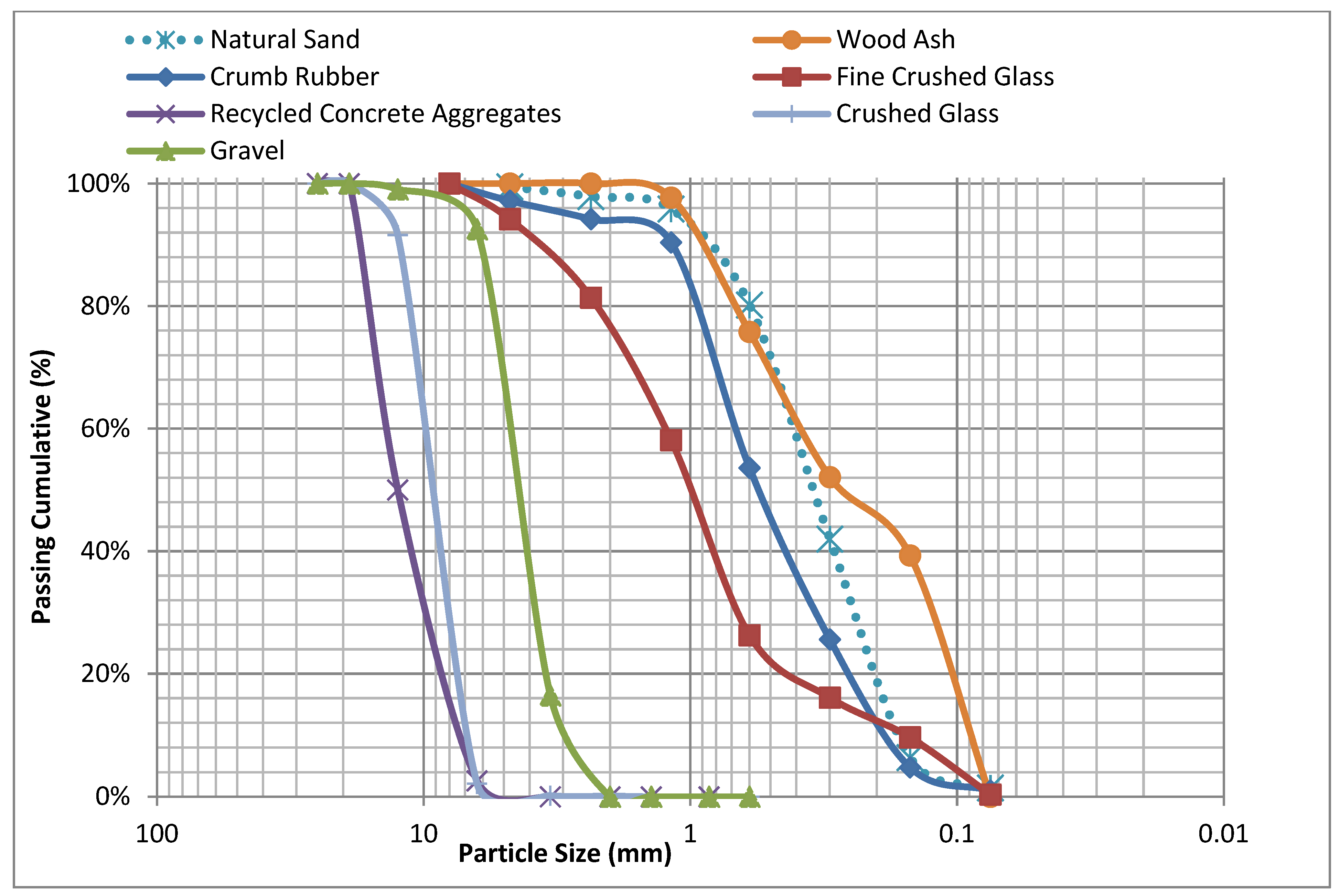
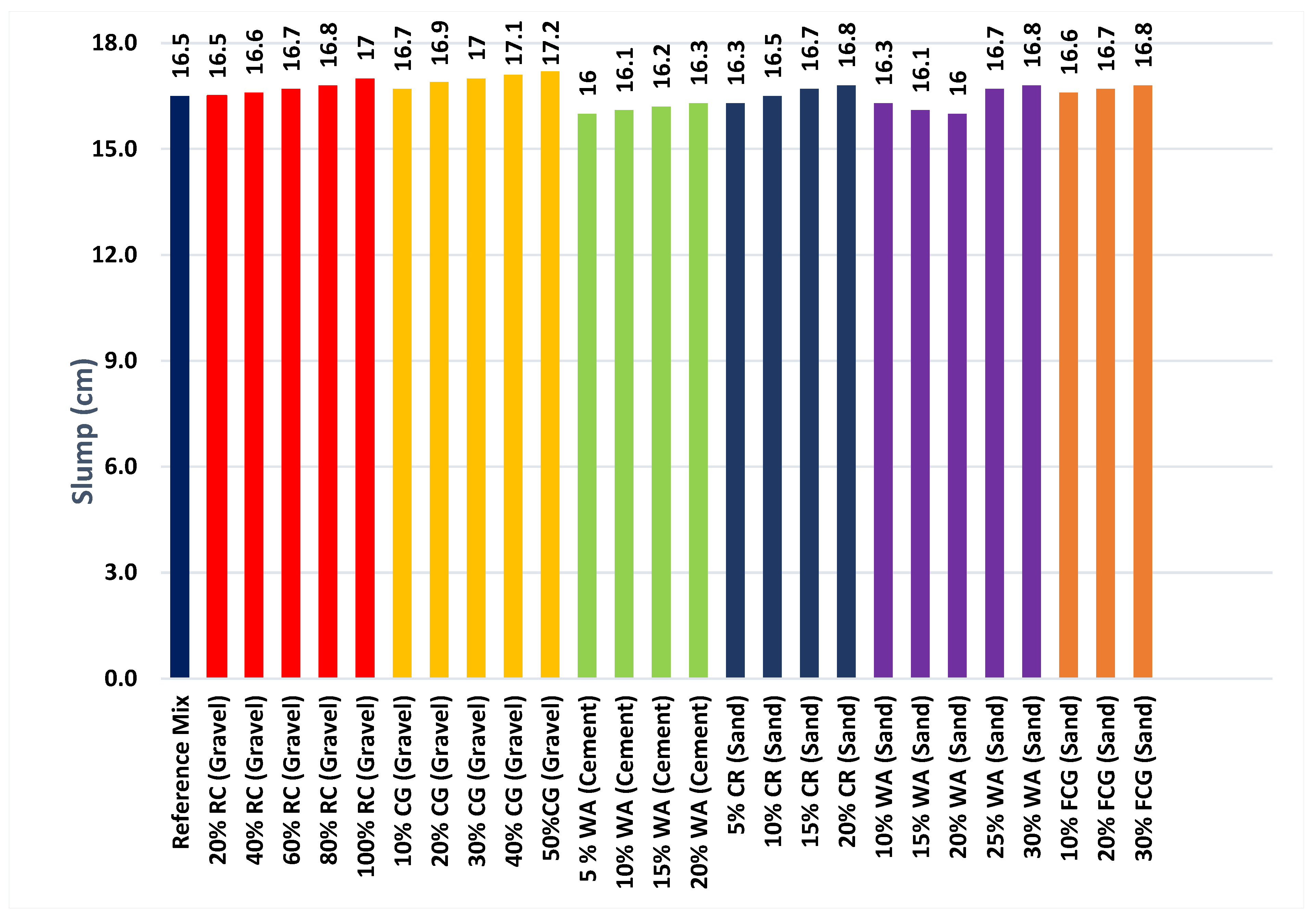
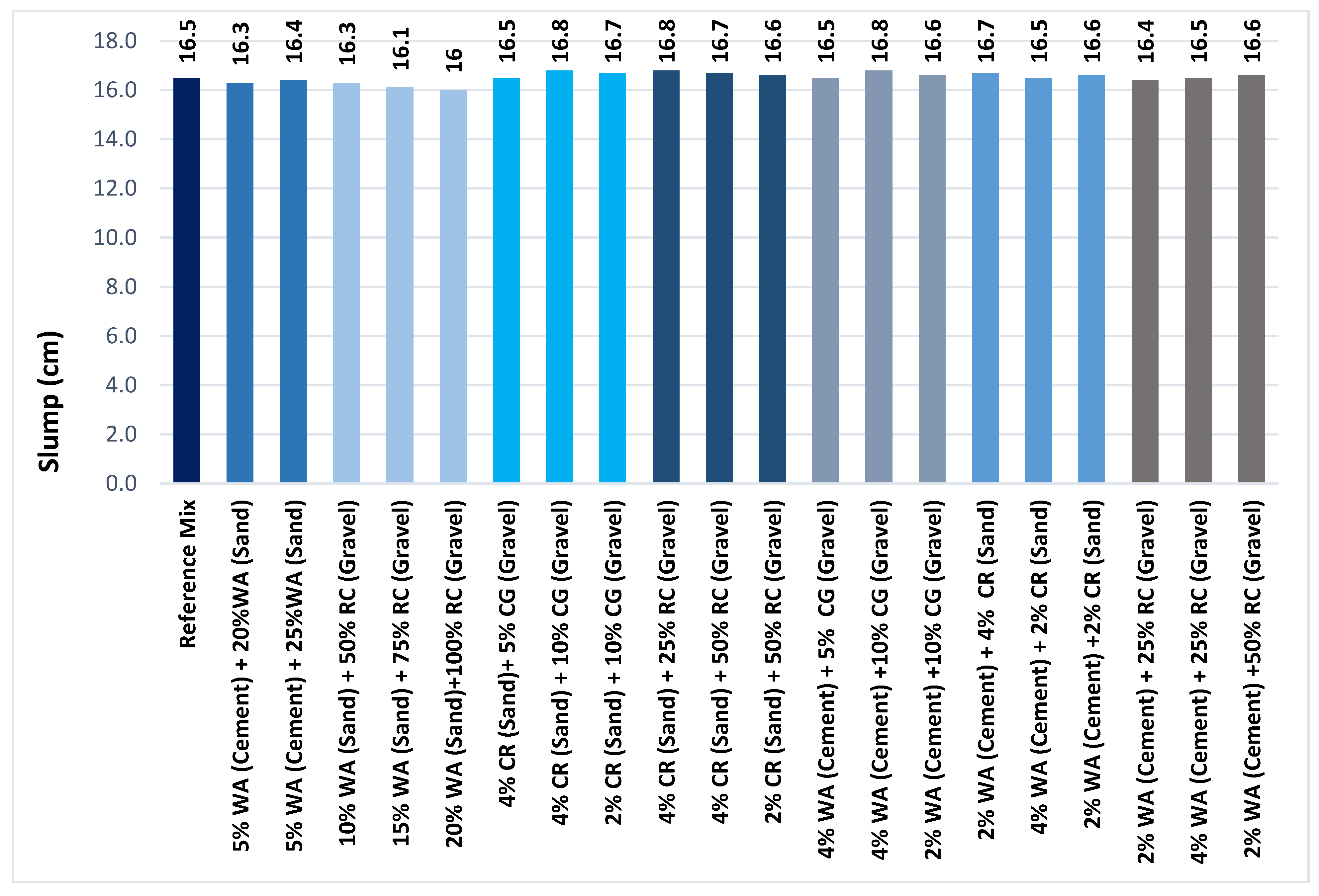

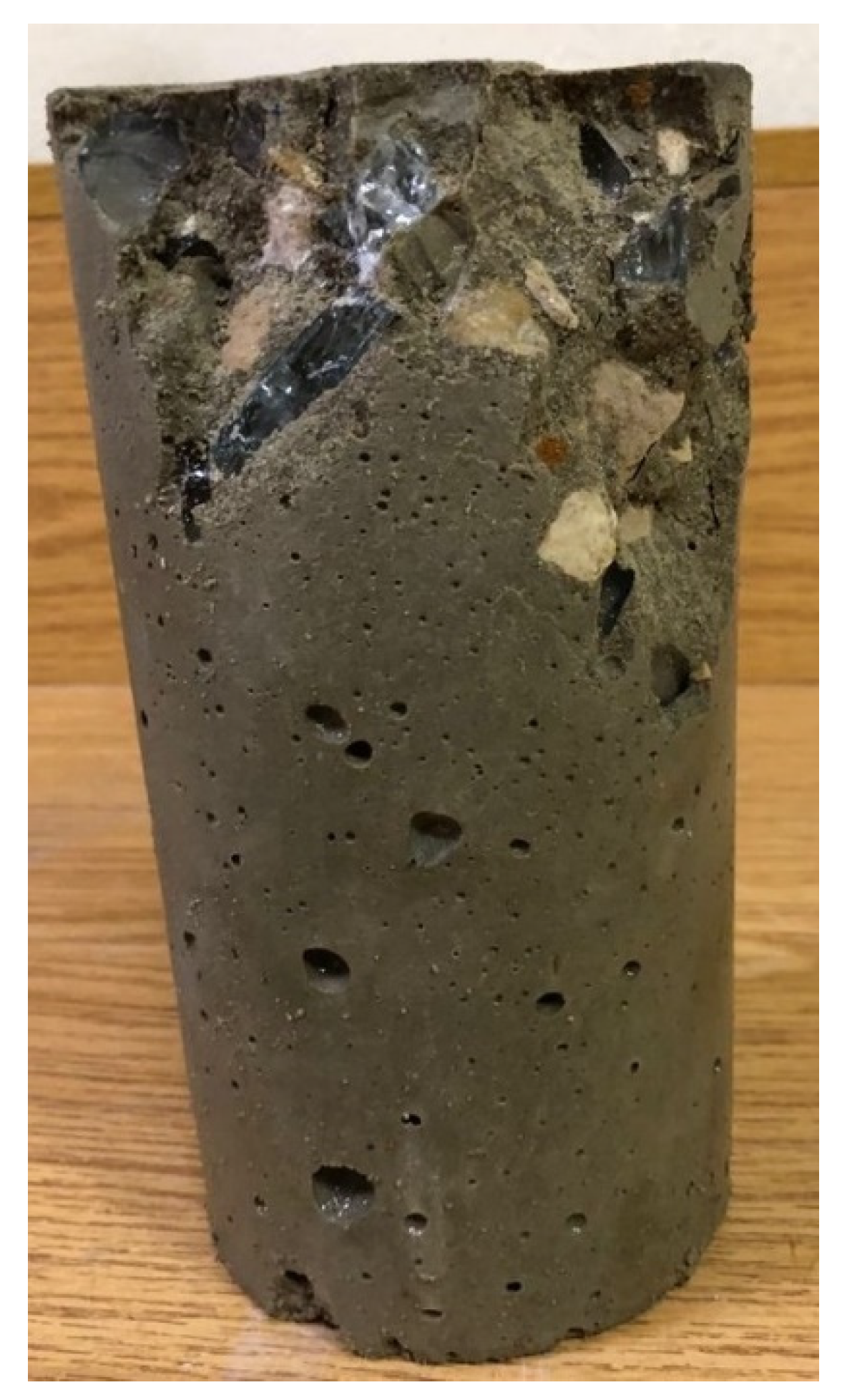
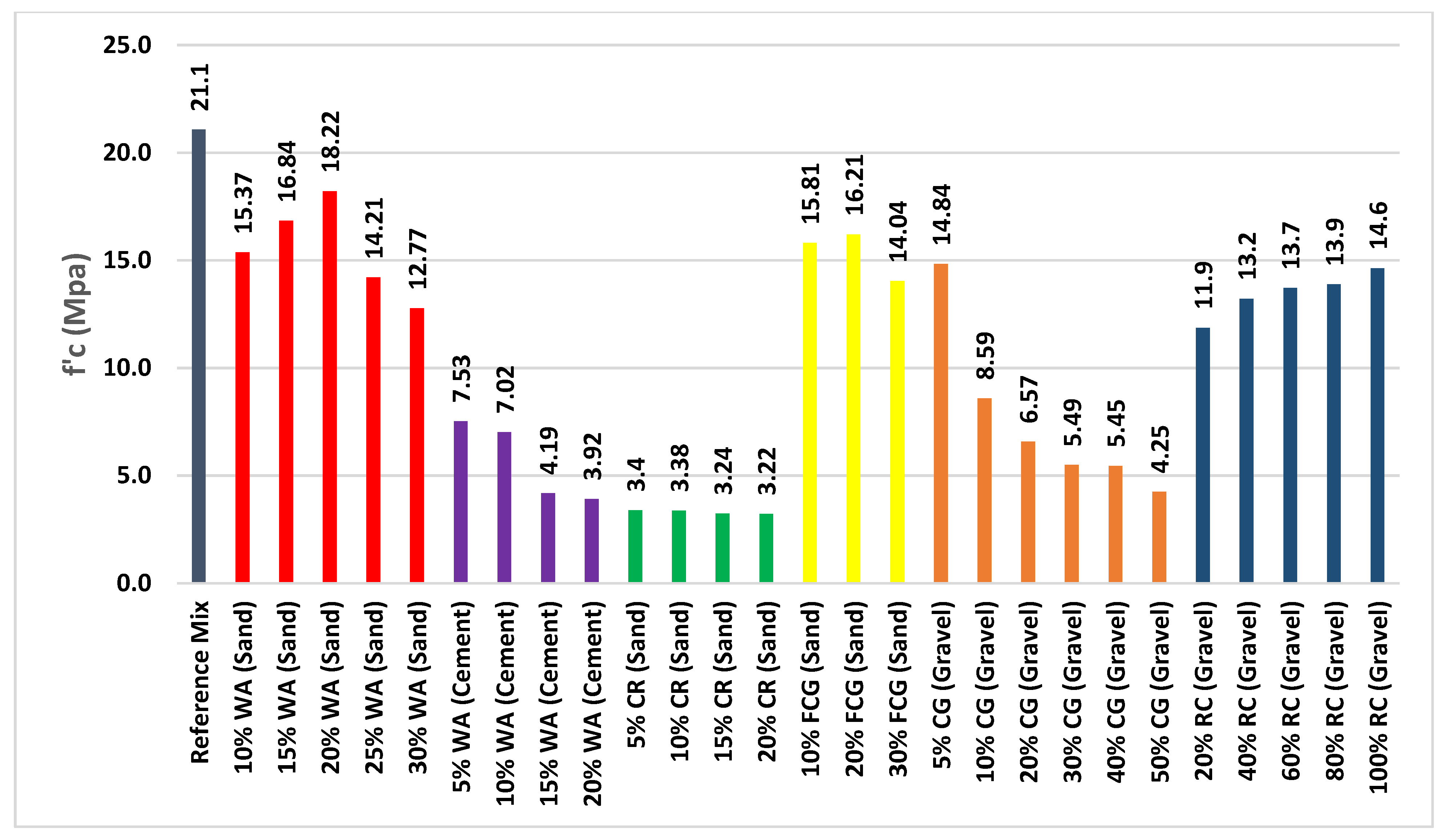
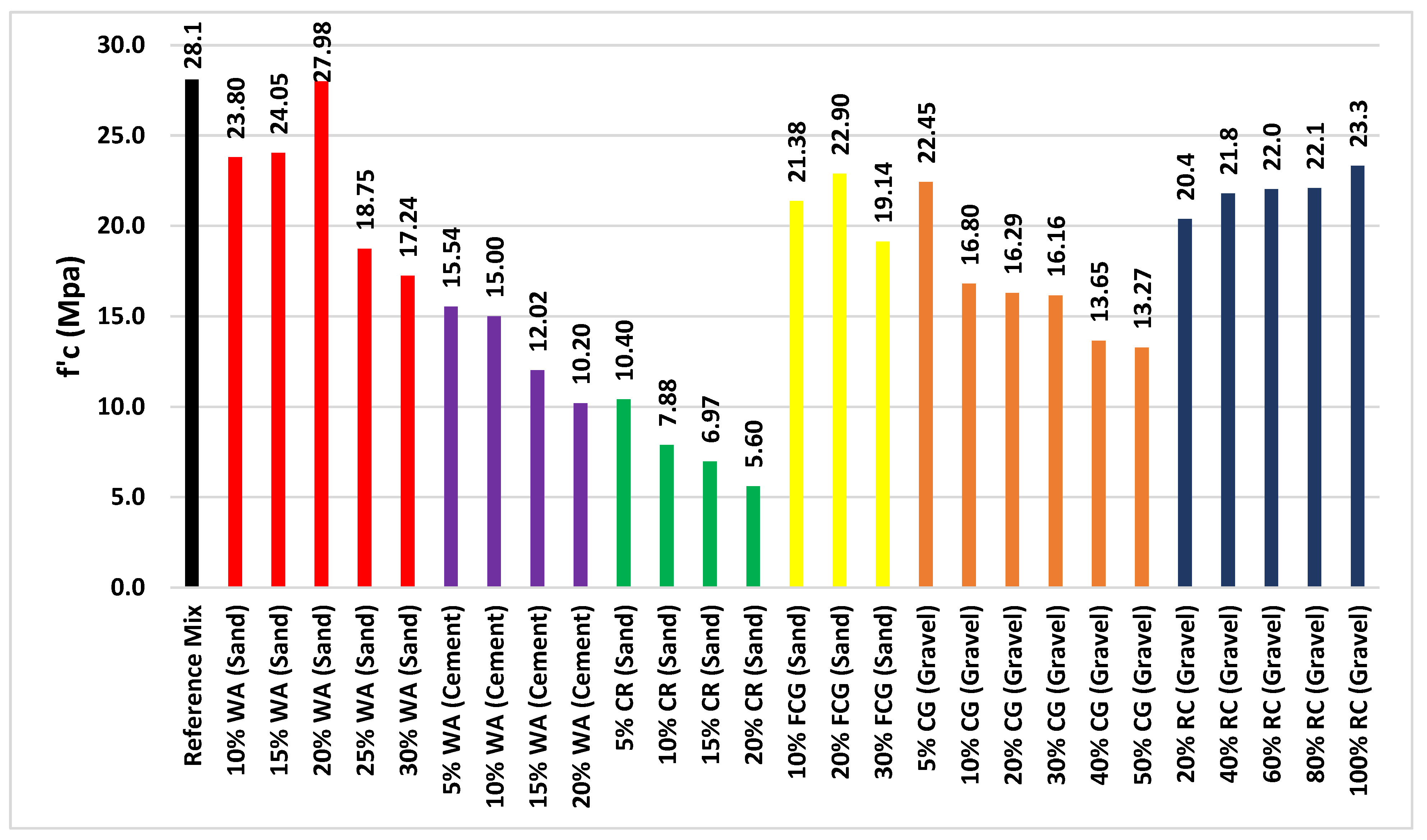
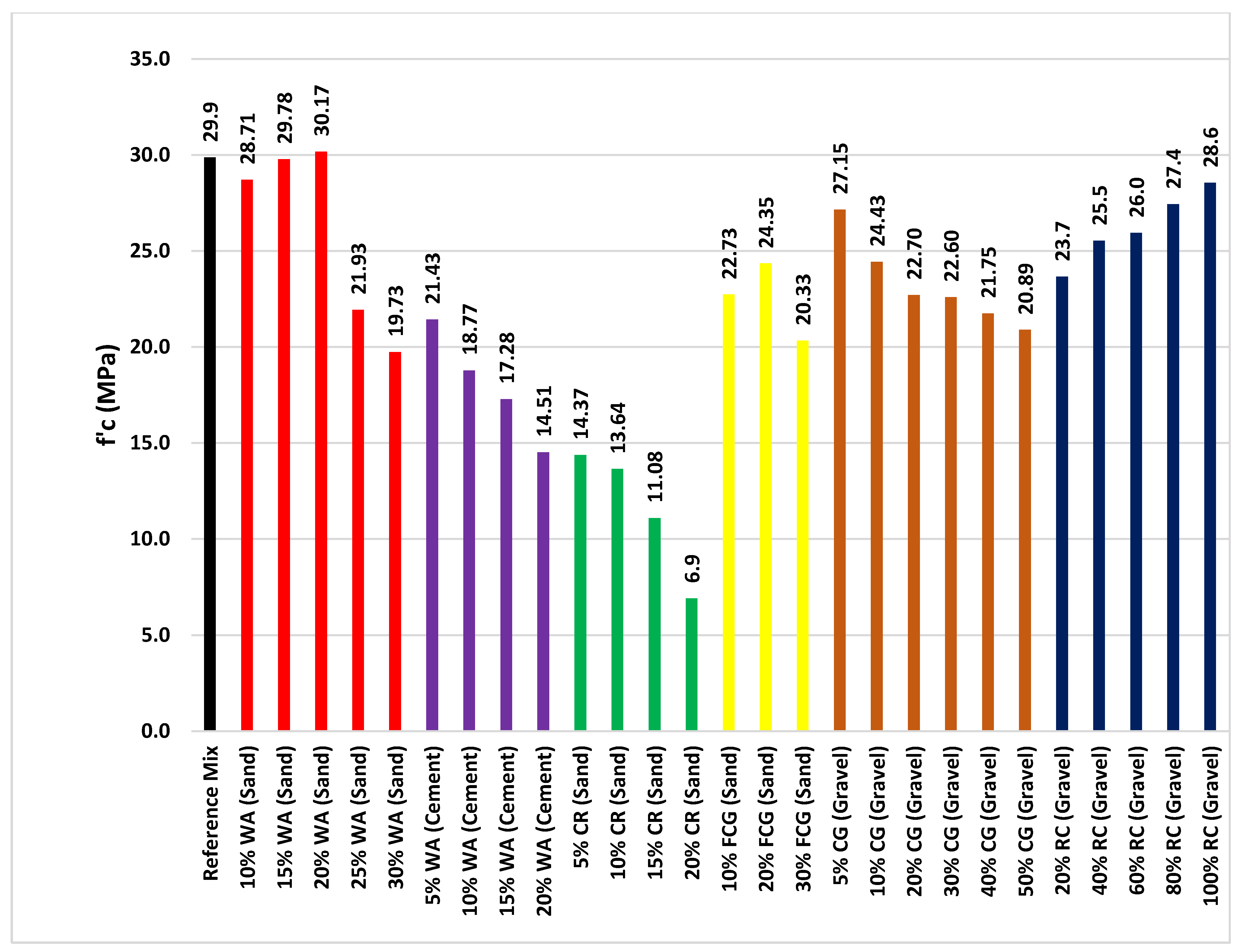
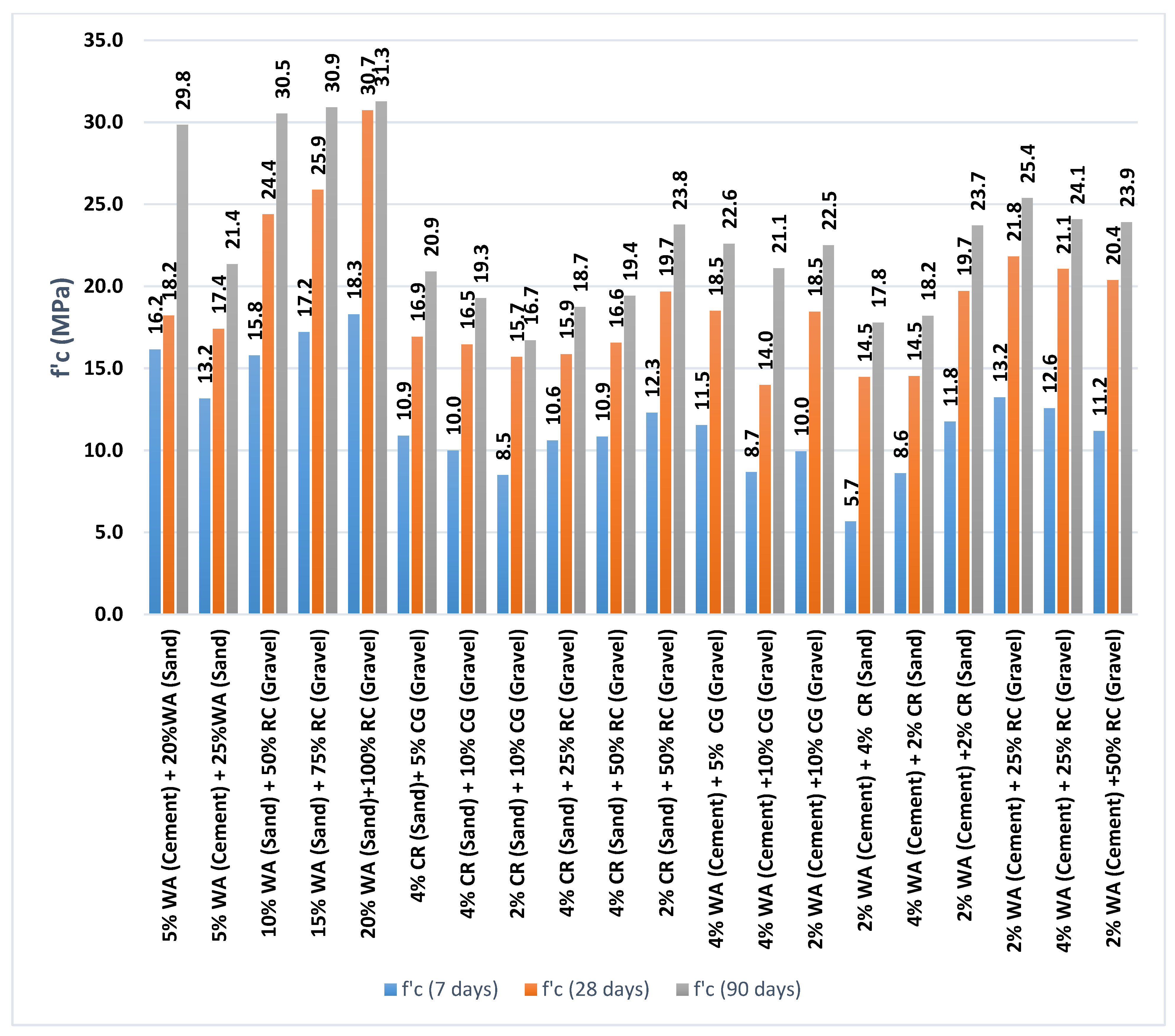
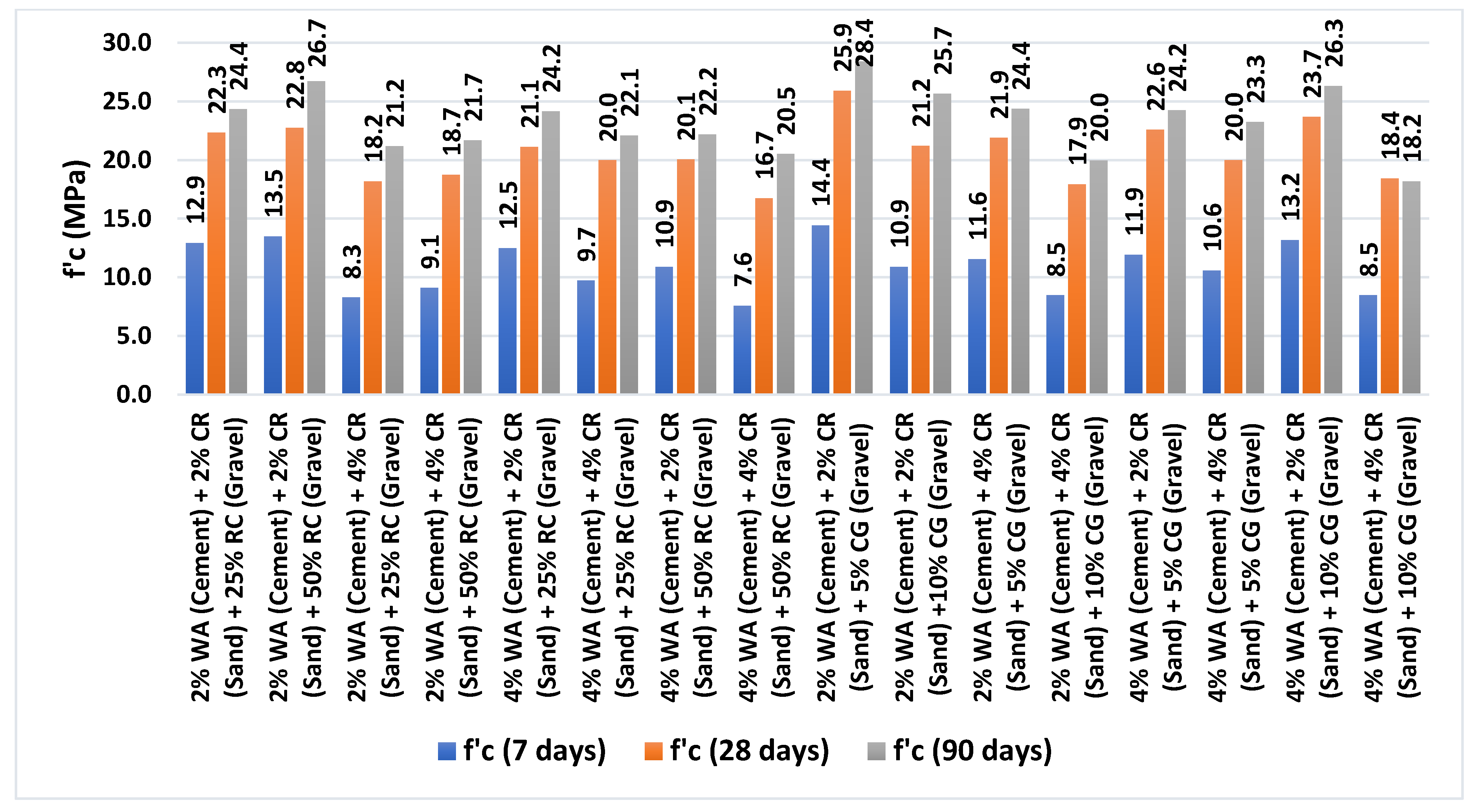


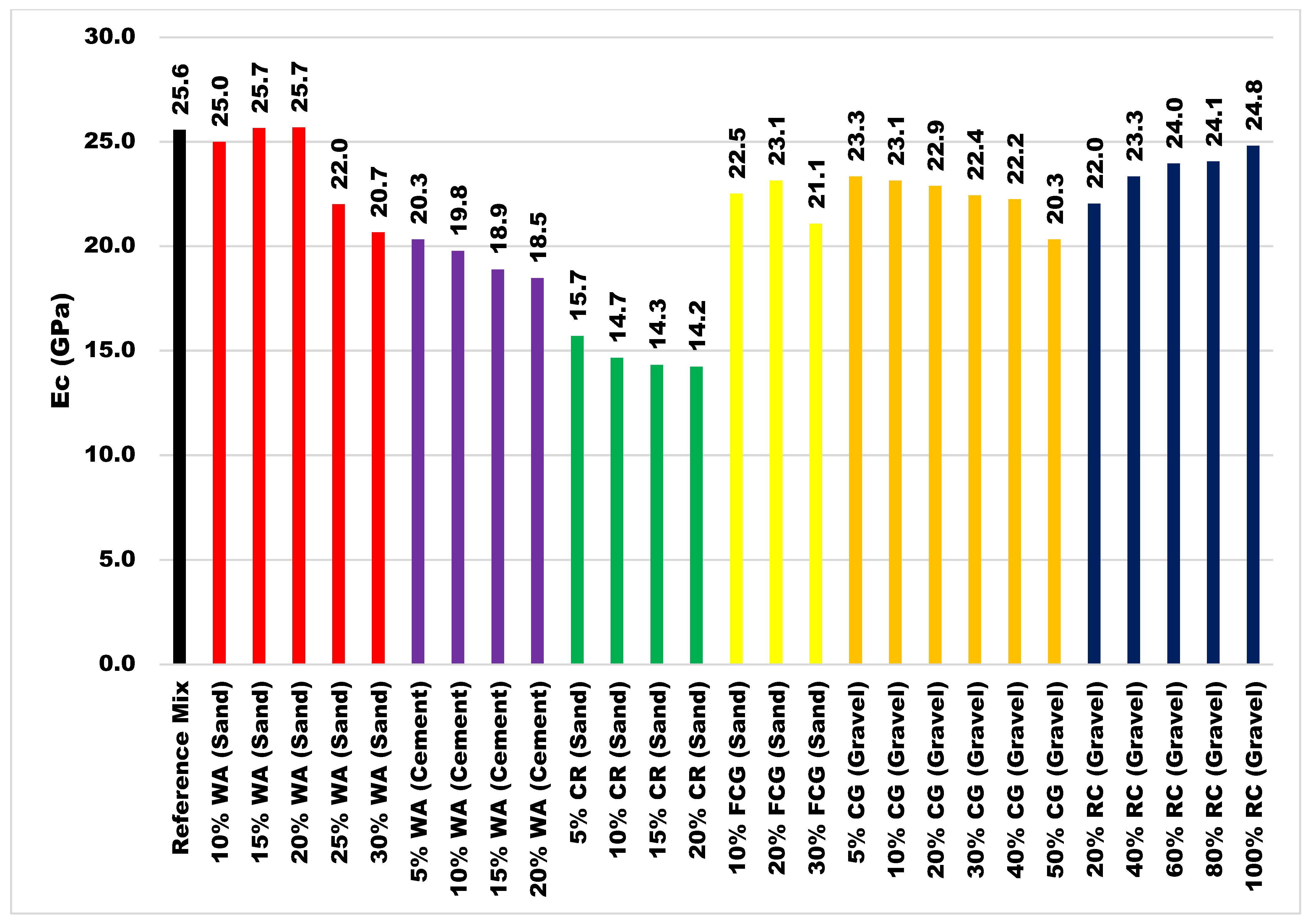
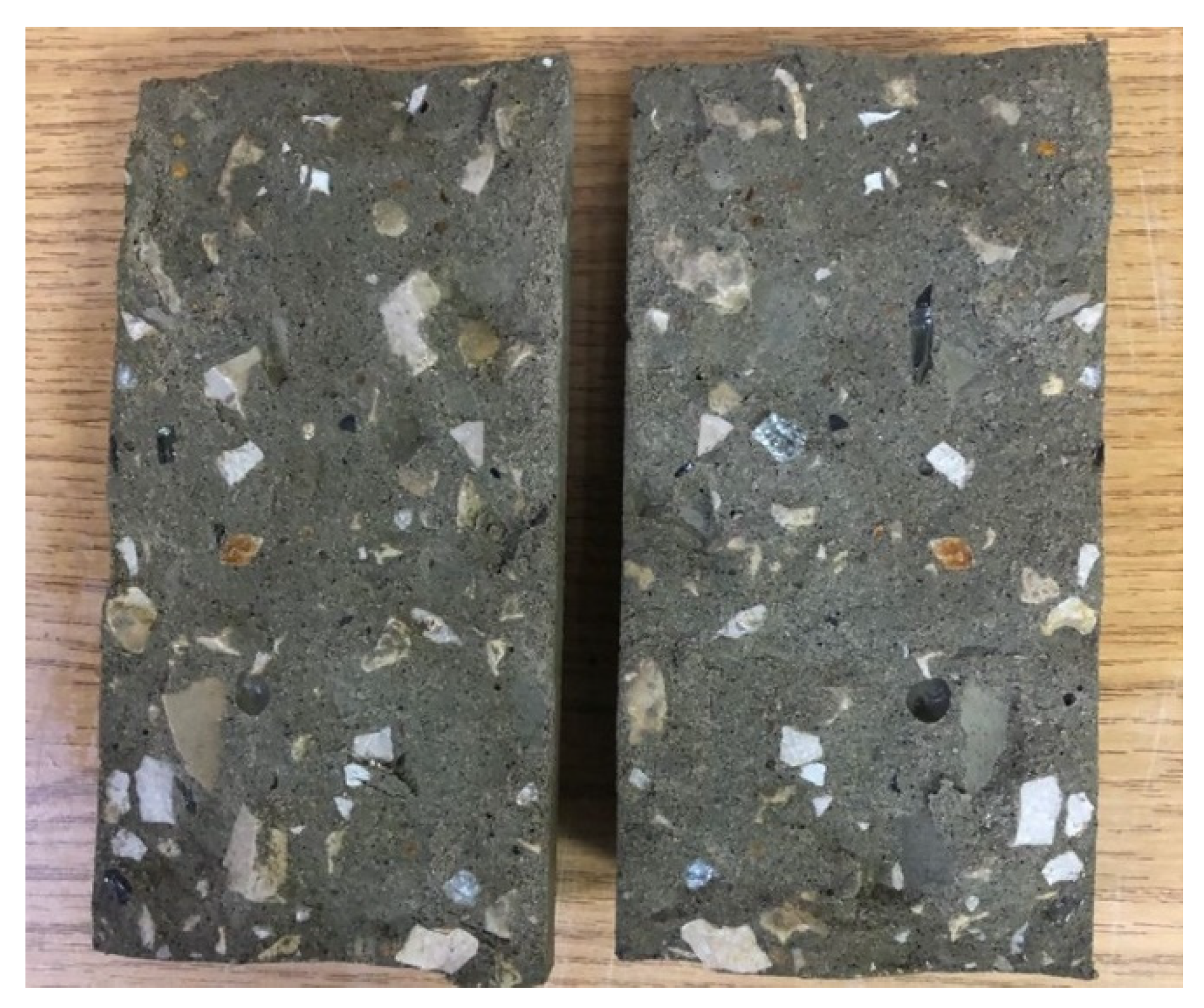

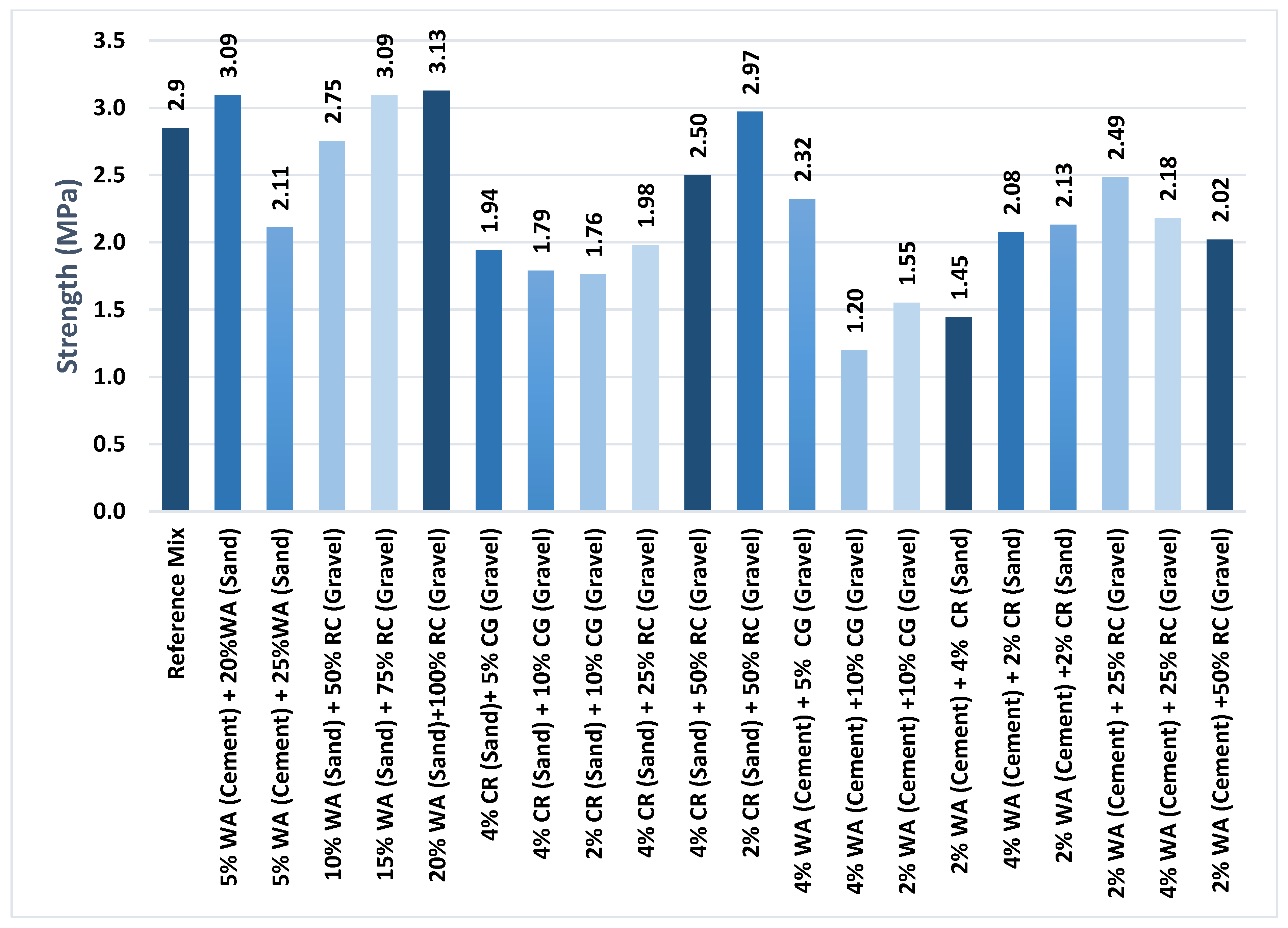


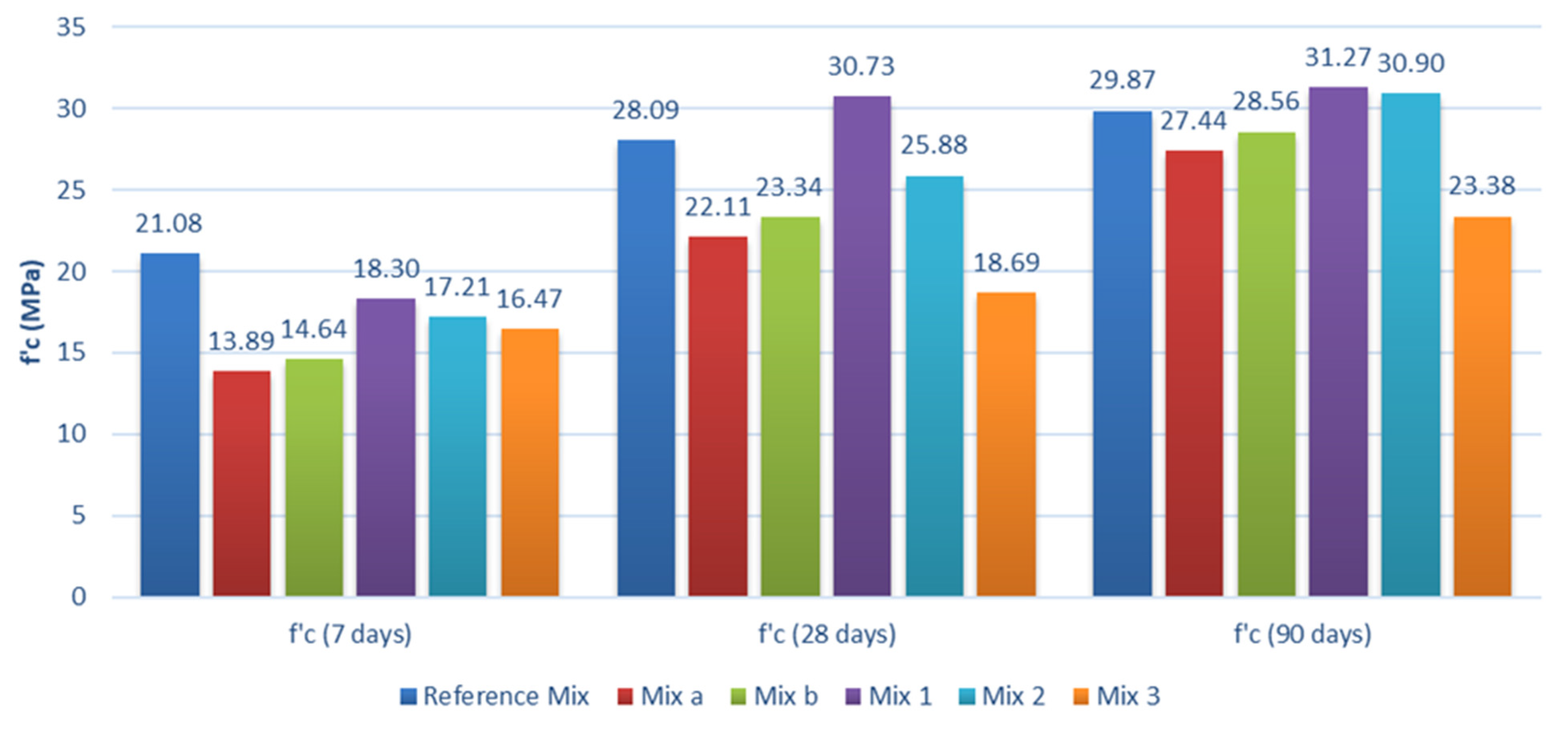
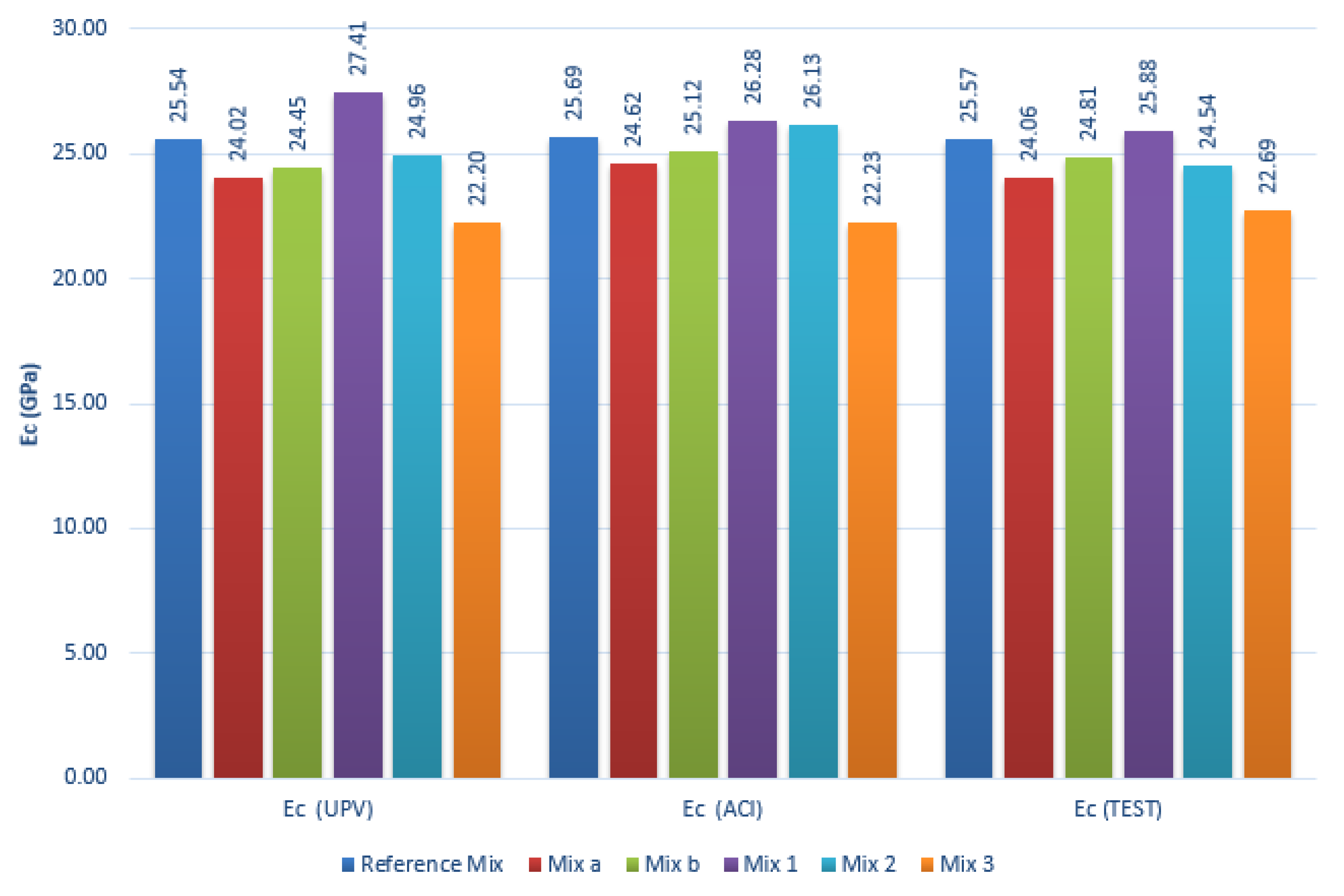

| Composition | % FCG | % WA | % CR | % CG |
|---|---|---|---|---|
| SiO2 | 70.56 | 37.86 | 26.5 | 72.61 |
| Al2O3 | 1.54 | 13.24 | 8.7 | 1.38 |
| Fe2O3 | 0.42 | 6.91 | 9.3 | 0.48 |
| CaO | 10.38 | 18.83 | 12.9 | 11.70 |
| MgO | 1.95 | 4.11 | 6.4 | 0.56 |
| Na2O | 14.14 | 1.39 | 1.4 | 13.12 |
| K2O | 0.36 | 2.36 | 1.1 | 0.38 |
| SO3 | --------- | ---------- | 1.6 | 0.09 |
| TiO2 | --------- | ---------- | 1.0 | --------- |
| CI | ---------- | ---------- | 0.1 | --------- |
| Zn | ----------- | ----------- | 20.2 | --------- |
| Loss on Ignition | 0.65 | 15.3 | 10.8 | 0.22 |
| Waste Type | Replaced Component | Percentage Replacements |
|---|---|---|
| WA | Cement | 2%, 4%, 6%, 8%, 10%, 15%, and 20% |
| WA | NS | 2%, 10%, 15%, 20%, 25%, and 30% |
| CR | NS | 1%, 2%, 3%, 4%, and 5% |
| FCG | NS | 10%, 20%, and 30% |
| CG | Gravel | 5%, 10%, 20%, 30%, 40%, and 50% |
| RC | Gravel | 20%, 25%, 40%, 50%, 60%, 75%, 80%, and 100% |
| Material | WA: Cement RC: Gravel | WA: Cement CR: NS | WA: Cement CG: Gravel | CR: NS RC: Gravel | CR: NS CG: Gravel | WA: NS RC: Gravel |
|---|---|---|---|---|---|---|
| % Replacement | 2% WA | 2% WA | 4% WA | 4% CR | 4% CR | 10% WA |
| 25% RC | 4% CR | 5% CG | 25% RC | 5% CG | 50% RC | |
| 4% WA | 4% WA | 4% WA | 4% CR | 4% CR | 15% WA | |
| 25% RC | 2% CR | 10% CG | 50% RC | 10% CG | 75% RC | |
| 2% WA | 2% WA | 2% WA | 2% CR | 2% CR | 20% WA | |
| 50% RC | 2% CR | 10% CG | 50% RC | 10% CG | 100% RC |
| Material | WA: Cement, CR: NS, and RC: Gravel | WA: Cement, CR: NS, and CG: Gravel |
|---|---|---|
| % Replacement | 2% WA + 2% CR + 25% RC | 2% WA + 2% CR + 5% CG |
| 2% WA + 2% CR + 50% RC | 2% WA + 2% CR + 10% CG | |
| 2% WA + 4% CR + 25% RC | 2% WA + 4% CR + 5% CG | |
| 2% WA + 4% CR + 50% RC | 2% WA + 4% CR + 10% CG | |
| 4% WA + 2% CR + 25% RC | 4% WA + 2% CR + 5% CG | |
| 4% WA + 4% CR + 25% RC | 4% WA + 4% CR + 5% CG | |
| 4% WA + 2% CR + 50% RC | 4% WA + 2% CR + 10% CG | |
| 4% WA + 4% CR + 50% RC | 4% WA + 4% CR + 10% CG |
| Mix Number | Mix Waste Components | f’c28 (MPa) | % Replacement by Volume |
|---|---|---|---|
| RC Replacing Gravel | |||
| Mix a | 80% RC | 22.11 | 20.95 |
| Mix b | 100% RC | 23.34 | 26.19 |
| WA Replacing Sand + RC Replacing Gravel | |||
| Mix 1 | 20% WA, 100% RC | 30.73 | 35.33 |
| Mix 2 | 15% WA, 75% RC | 25.88 | 26.5 |
| WA Replacing Cement + CR and WA Replacing Sand + RC Replacing Gravel | |||
| Mix 3 | Optimum Eco-Friendly Mix | 18.69 | 34.63 |
Publisher’s Note: MDPI stays neutral with regard to jurisdictional claims in published maps and institutional affiliations. |
© 2022 by the authors. Licensee MDPI, Basel, Switzerland. This article is an open access article distributed under the terms and conditions of the Creative Commons Attribution (CC BY) license (https://creativecommons.org/licenses/by/4.0/).
Share and Cite
Gerges, N.N.; Issa, C.A.; Sleiman, E.; Aintrazi, S.; Saadeddine, J.; Abboud, R.; Antoun, M. Eco-Friendly Optimum Structural Concrete Mix Design. Sustainability 2022, 14, 8660. https://doi.org/10.3390/su14148660
Gerges NN, Issa CA, Sleiman E, Aintrazi S, Saadeddine J, Abboud R, Antoun M. Eco-Friendly Optimum Structural Concrete Mix Design. Sustainability. 2022; 14(14):8660. https://doi.org/10.3390/su14148660
Chicago/Turabian StyleGerges, Najib N., Camille A. Issa, Elias Sleiman, Sara Aintrazi, Jad Saadeddine, Remi Abboud, and Marc Antoun. 2022. "Eco-Friendly Optimum Structural Concrete Mix Design" Sustainability 14, no. 14: 8660. https://doi.org/10.3390/su14148660






